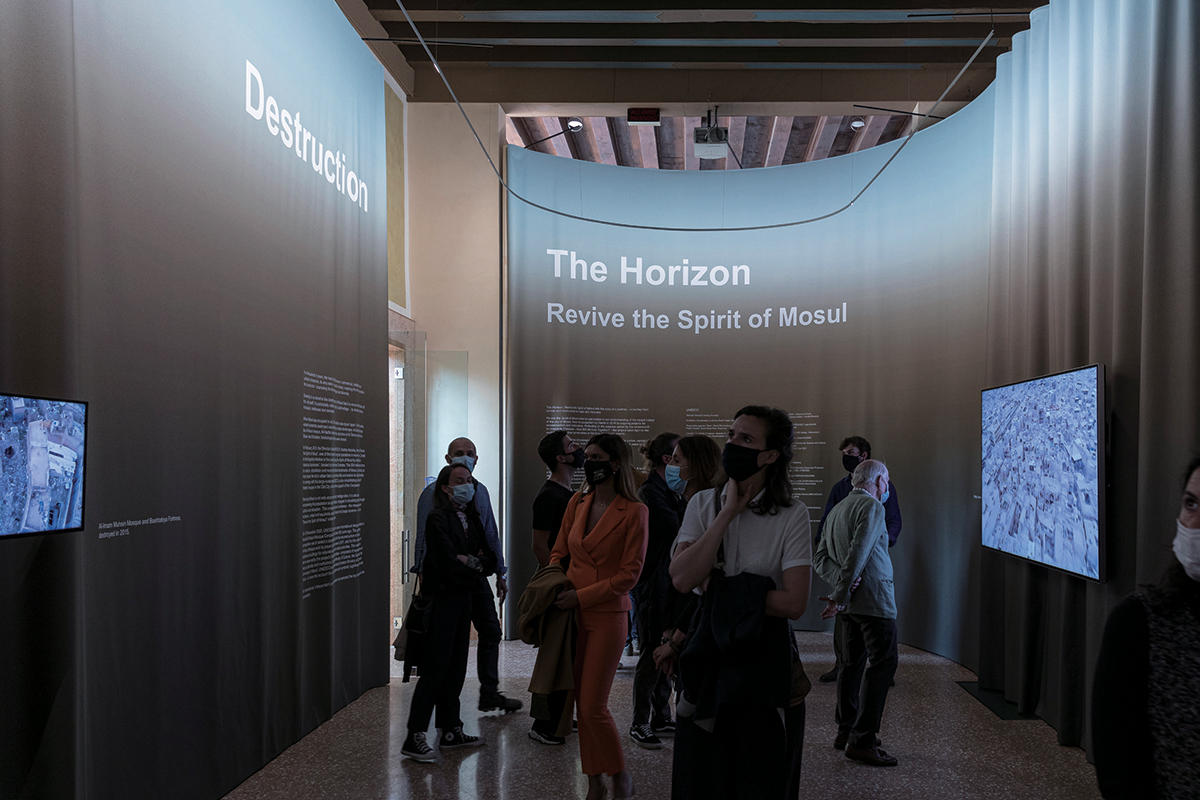
Exhibition view ©Laurian Ghinitoiu ©Laurian Ghinitoiu
In collaboration with the Government of Iraq and the Ministry of Culture and Youth of the United Arab Emirates, UNESCO presents ‘The Horizon: Revive the Spirit of Mosul’ as a auxiliary event at the 2021 Venice Biennale. A city sitting at the junction of the Tigris river, Mosul, as its Arabic name suggests, is the ‘linking point’ between diverse ethnicities and religious beliefs. The three-year-long occupation by IS (Islamic State of Iraq and the Levant) from
2014 to 2017 has left the city in ruins and its people displaced. In the aftermath, in February 2018, UNESCO launched its reconstruction project ‘Revive the Spirit of Mosul’. Casting the Al-Nouri Mosque and the Al-Hadba Minaret as the protagonists of the reconstruction project, the exhibition presents a journey in pursuit of the lost spirit of Mosul. Here, Kim Seonwoo discusses the changing paradigms and methodologies of reconstruction with Ippolito Pestellini Laparelli and Francesca Lantieri of 2050+, who designed and curated the exhibition.
Unravelling Across a Horizon
Upon entering the halls, one sees a gradient of blue, white, and brown reach around the walls. The curtain weaves through the four stages of Mosul’s history – ‘destruction’, ‘liberation’, ‘actions’, and ‘future’ – and becomes the literal horizon line of the exhibition. The horizon is always there; if one looks beyond where the sky meets the ground, one may glimpse the horizon of yesterday in today’s rubble. The horizon is the past, the present, and the future of Mosul. Falling elegantly from the ceiling to the floor, the curtain curves gently or in dense ripples, itself embodying the timeline of Mosul’s history. Ippolito Pestellini Laparelli and Francesca Lantieri of 2050+ unfold ways of reading the exhibition through the horizon.
Kim Seonwoo: The exhibition is entitled, ‘The Horizon’. How does the word ‘horizon’ relate to the content of the exhibition?
2050+: The horizon is simply an abstraction of Mosul’s skyline which is represented through the gradient printed on the curtain, the main exhibition feature, unfolding from the beginning to the end of the parkour. This provides context to the different supports, as well as serving as an infographic that highlights different moments in the narration, as it extends through the different exhibition rooms. The ratio of ground and sky are suggestive of phases of destruction, where the contents are displayed below the horizon line, and the phases of reconstruction, where the contents sit above the horizon. The curtain features a gradient between blue and brown— beige, which moves in parallel to the content of the show, moving from a dusty background to a deeper blue: from destruction to regeneration.
Kim Seonwoo: Chronology seems to play a big role in the exhibition with the pavilion divided into four phases—destruction, liberation, actions, and the future. Can you tell us more about the sequence between the four spaces?
2050+: The chronology pursued in the exhibition articulates in the overarching narrative the different historical stages of Mosul—both in the recent past and projected into the years to come. Each room focuses on a specific moment: the destruction of the monuments, the liberation from the occupants and the verification of the damage, the actions taken by the UNESCO programme, the future, beginning with the Al-Nouri Mosque reconstruction. The display culminates with the competition boards, highlighting the winning proposal at the end of the path through the exhibition.
Kim Seonwoo: The first thing one notices in the installation is the presence of the undulating curtain. The softness of the backdrop contrasts with the sharp images of destruction and the reconstruction of the Al-Nouri Mosque. Can you tell us more about your design choices and procedures?
2050+: The curtain, unravelling through the different rooms of the main floor of Palazzo Zorzi, serves as a guide for the visitors. The main design aim of the curtain was for it to function as a background, precisely defining the domains of the display, as well as a canvas for information (data, texts, testimonies) beyond the different supports in the exhibition. The pleats of the curtain suggest the intensity of specific events by highlighting a series of particularly disruptive moments in the chronology. Overall, the curtain offers a spatial experience to the visitors both concealing and revealing the spaces of Palazzo Zorzi.
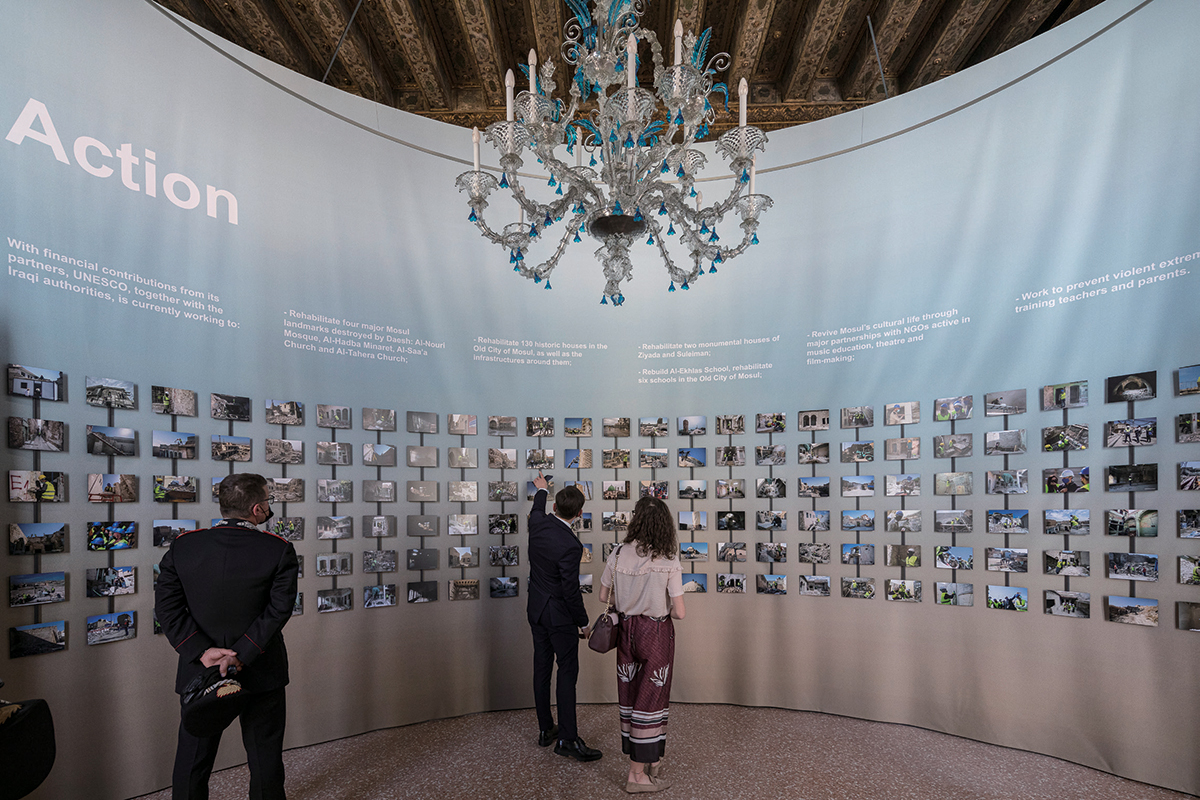
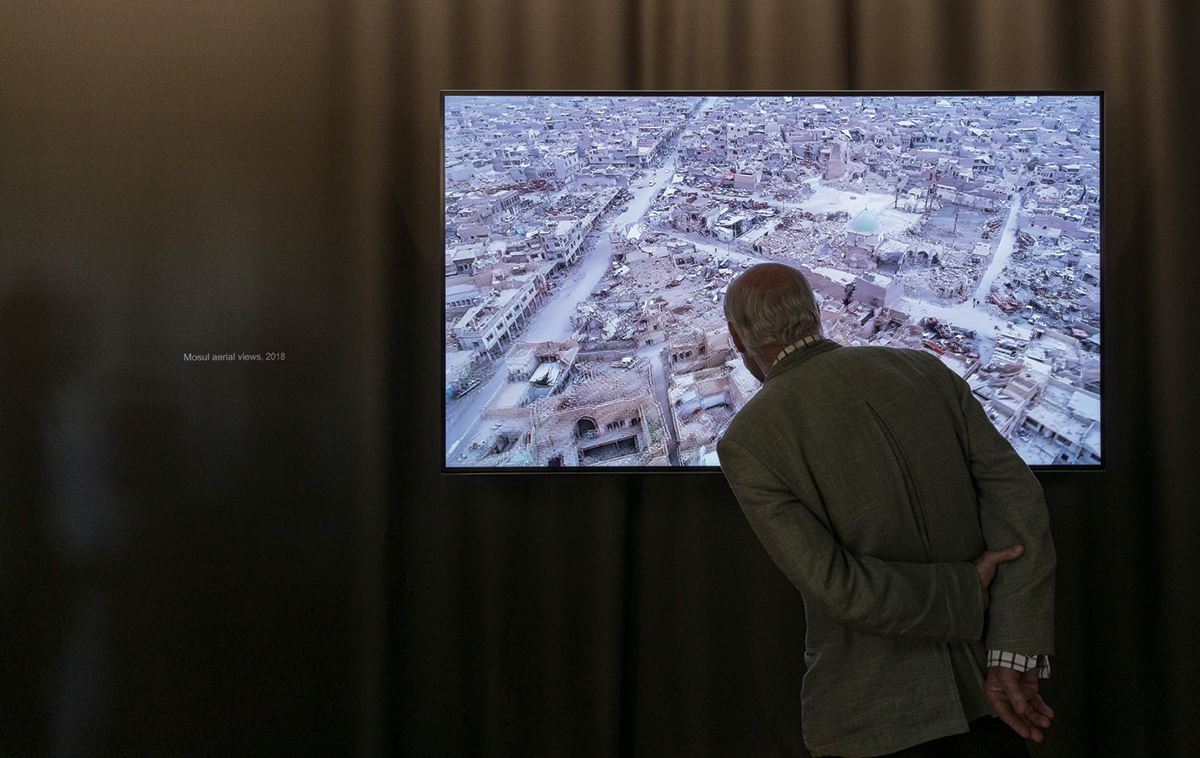
Exhibition view ©Laurian Ghinitoiu
Kim Seonwoo: What was it like to install the exhibition in Palazzo Zorzi? As we understand it, Palazzo Zorzi is itself a restoration project. How did the spatial character of Palazzo Zorzi influence your design?
2050+: The rigidity of the space and the fragmentation into different rooms influenced our design choices on the one hand and the curatorial narration of the exhibition on the other hand. The curtain, which constitutes the pivotal element in the exhibition set-up, unifies the otherwise divided nature of the exhibition space and it represents the chronological sequence of the narration. Additionally, the design process had to address the technical restrictions of the building: we had to develop a system completely detached from the walls. A self-supporting structure holding up the curtain and the displays allowed us to solve this. The curtain acts a selective device, taking over specific portions of the rooms and adding a non cartesian, softer system to an otherwise very orthogonal sequence of spaces.
Kim Seonwoo: How did architecture agency 2050+ and UNESCO decide on the nature of this collaboration? Were there any specific requests or restrictions posed by the clients? How were they negotiated?
2050+: There was a competition launched by UNESCO addressing the setup and curatorial strategy behind ‘Revive the Spirit of Mosul’ exhibition. We teamed-up with ALTOFRAGILE, a production agency with whom we often collaborate, to devise the proposal. After selection, the process was straightforward: UNESCO provided us with a wide range of materials and we made our curatorial selection. The real constraints were the lack of time and the restrictions arising from a protected building—they became the real challenges of the project.
Kim Seonwoo: The competition for the reconstruction and rehabilitation of the Al-Nouri Complex is, of course, central to the exhibition. Reconstruction is often imagined differently from a project to a project. How does the exhibition define or reimagine ‘reconstruction’?
2050+: The way reconstruction is imagined inevitably differs from project to project, and this is clearly shown in the room in which the selected proposals are exhibited. We focused on linking the background and the history of the city to its future through the eyes and voices of local people. This is represented in the liberation room where a series of interviews follows the map of the IS occupations and destruction. We believe that the first important step towards reconstruction is beginning with people’s perspectives and hopes.
Kim Seonwoo: The reconstruction of the mosque and the city now involves digital tools and representations. A high- resolution 3D scan model of the Al-Nouri Mosque was included as a package in the competition brief. Due to the pandemic, this year’s biennale must rely on images to communicate with a wider audience. How did the exhibition deal with this new reality?
2050+: There is an interesting link between the pandemic restrictions and the impossibility of reaching remote places affected by war. This exhibition represented a chance to
bring to light the images of sorrow and destruction of the city of Mosul that has been forgotten by many people. Drone shootings and 3D reproductions give a completely different perspective to the audience, developing a greater understanding of the level of destruction but also acknowledging the cultural richness and majesty of
this place, which risked getting lost. Unquestionably, the Al-Nouri Mosque is the most important manifestation of this risk.
Kim Seonwoo: ‘How Will We Live Together?’ was the theme chosen by Hashim Sarkis for this year’s Biennale. How did the exhibition translate this issue in the context of Mosul?
2050+: One of the goals of the exhibition is to show the importance of reconstruction of heritage monuments as means of establishing common ground between different cultures. This responds to the general theme of the Biennale, ‘How Will We Live Together?’, guiding the visitors from scenes of sorrow and destruction to those of hope and repair. The entrance portico – an interface between the institution and the city of Venice – is used to announce the exhibition: the image of the destroyed Al-Nouri Mosque introduces the visitors approaching the venue to the exhibition space, while a picture of reconstruction efforts guides them towards the end of the show.
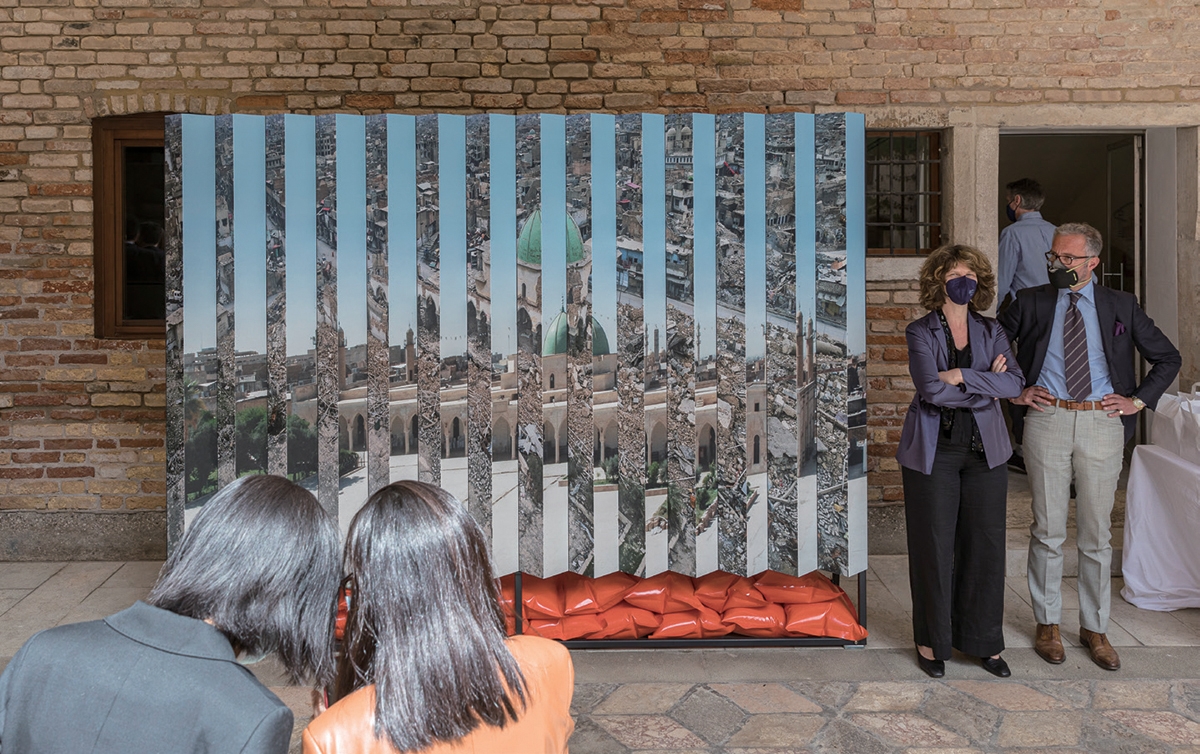
The entrance of exhibition hall ©Laurian Ghinitoiu
Reconstruction of the Corpus and the Spirit
Palazzo Zorzi, where the exhibition took place, is UNESCO’s regional office in Europe. Palazzo Zorzi was completed in the early 16th century, when Mauro Codussi’s renaissance design was added to the existing gothic building. Passing through ownership of multiple owners, the house was left in a dire state of repair. In the 1980s, the municipality launched a 20-year-long restoration project. In 1995, the ownership of the building was handed over to UNESCO. There is something special about narrating Mosul’s reconstruction inside Palazzo Zorzi in Venice. Framed within the city that continues to degenerate and regenerate, how does the exhibition understand and differentiate ‘reconstruction’, when the memory of the thing that is lost is entangled with violence and trauma? Entering the courtyard of Palazzo Zorzi, one encounters two versions of Mosul. From the left side of the installation, one sees the Al-Nouri Mosque amidst the rubble, barely recognisable except for its green dome. From the right, one sees the Al-Nouri Mosque standing tall and proud, as if no violence has ever touched it. A relatively simple idea – to create an enlarged lenticular image by intersecting the two photos like an accordion – as it stands the installation works; it presents a poignant picture of how Mosul is today, torn between the past and the present. The steel frame which holds up the installation is weighted by piles of orange sandbags which emphasise the sense of being in-between. In November 2020, UNESCO launched the international design competition for the reconstruction and rehabilitation of the Al-Nouri Complex. This year in April, UNESCO announced the winner of the competition. The proposal by Salah El Din Samir Hareedy and his team, ‘Courtyard Dialogues’ has been praised for its nuanced vernacular, its sensitivity to materials, and for its artful curation of the courtyards that feed into the main square. The beginning of the reconstruction is scheduled later this year. The Al-Nouri Complex has lived several lives well before UNESCO’s ambitious interventions. In 1942, as part of the Iraqi government’s restoration project, the mosque was dismantled and then reassembled a new layout. The Iran-Iraq war from 1980 to 1988 severely damaged the pipelines under the minaret and has rendered the ground dangerously weak. The minaret, which was already beginning to tilt, leaned even further, forming a dangerous but impressive angle. The Al-Nouri Complex, loved greatly by the people of Mosul and Iraq is already an accumulation of destruction and reconstruction. Can the reconstruction, as advertised in the exhibition, preserve the strata of Mosul’s diverse and tumultuous history in its totality? Can UNESCO successfully revive the spirit of Mosul? UNESCO, in recent years, has departed drastically from its own operating protocols. The Venice Charter of 1964 (The 1964 International Charter on the Conservation and Restoration of Monuments and Sites) rules out reconstruction and states that restoration must stop where conjecture begins. However, since the destruction of Sufi mausoleums at the Timbuktu World Heritage Site in Mali in 2012, UNESCO has lead competitive reconstruction projects around the world. UNESCO’s collateral event ‘The Horizon: Revive the Spirit of Mosul’ at the 2021 Venice Biennale, manages to revive the spirit of ‘Mosul’ on the world stage despite facing unprecedented restrictions in the Coronavirus Disease-19 pandemic. While the occupation in Mosul ended in 2017, acts of terrorism and war continue well into 2021. Time will tell whether the new paradigm and methodology of ‘reconstruction’ proposed by UNESCO will successfully restore communities to Mosul. However, the exhibition has provided us with a horizon, in which the timelines of Venice and Mosul meet and blur the opposing ideas of ‘reconstruction’.
*‘The Horizon: Revive the Spirit of Mosul’ was on display from the 22nd of May to the 21st of November, 2021 in Palazzo Zorzi, Castello, Venice. The exhibition was designed and curated by the 2050+ and installed and produced by ALTOFRAGILE.
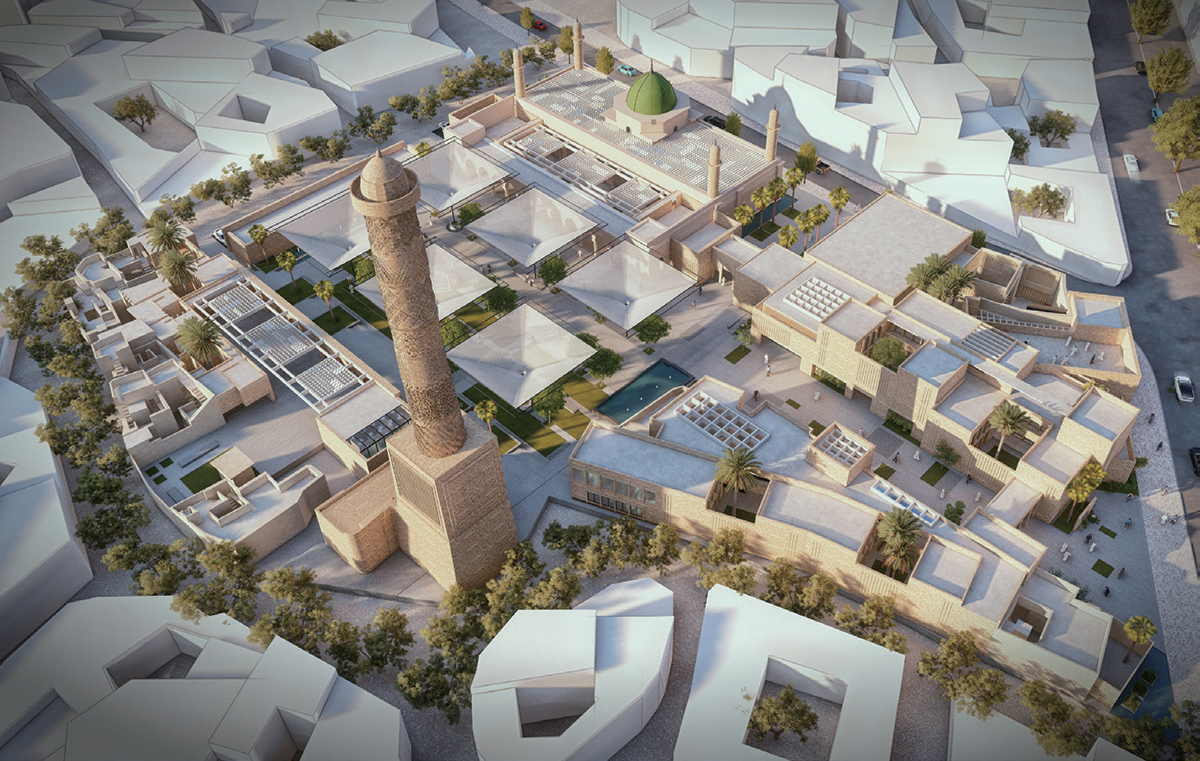
Winning proposal's image / Image courtesy of UNESCO ©Salah Hareedy + Khaled El-Deeb + Sherif Ebrahim & Tarek Ali Mohamed





